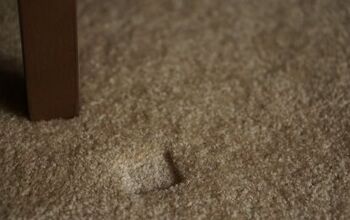How to Protect Your Plants From Cats

Every proud cat owner knows that cats love to let their curiosity get the best of them. That’s especially true when you have houseplants that are simply too tempting for them to ignore. Whether it be digging them up or eating your plants, it’s a problem. It’s hard to stop them, so you may understandably struggle with how to protect your plants from cats.
Place your plants on windowsills and shelves or hang them to protect them from your cats. Cats hate citrus, so you can keep them away from your plants if you put orange peels on the soil. Your best bet to protect your plants is to put them all in one room so you can close the door.
It also helps to play with your cats more often and plant cat-safe plants to satiate their plant fixation. Follow along as we explore how to protect your plants from cats.
So, How Do I Stop My Cat From Destroying My Plants?
The easiest way to stop your cat from destroying your plants is to keep them out of reach. There are many ways to do this, and some cat deterrents are more creative than others. Check out these simple steps you can take to protect your plants from your cats.
1. Put Them On The Windowsill
It’s hard for a cat to destroy your plants if they can’t reach them. Put your plants on the windowsill to limit your cat’s access. Not only will the plants get a great light source, but you won’t have to worry about your cats eating them.
Of course, this primarily only works with smaller plants. That said, you can easily build a shelf extension by your window to accommodate more plants.
2. Use Plant Stands
The higher up you put your plants, the harder it will be for your cats to reach them. Today, you can find a variety of stands for potted plants that come in many heights. That said, you must be careful about where you put the plant stand, as cats are quite acrobatic.
Make sure the plant stands are far enough away from surfaces your cats can jump from, such as countertops.
3. Grow Cat Grass
One of the best ways to protect your plants from cats is to give them a plant to distract them. Cat grass is a grass mixture that cats love, and it’s safe for them. It typically contains rye and wheat, and it’s easy to grow in your home.
This method works similarly to setting up scratching posts so your cats don’t scratch the furniture. Hopefully, the grass will satisfy your cats enough to stay away from your other plants. Of course, you’ll still want to use other methods as well, but this is a great starting point.
4. Use Citrus Spray
The smell of citrus is both calming and appetizing, at least to humans. Cats, on the other hand, hate citrus, and the smell alone is enough to keep them away. Citrus sprays cost $5-$15, and you can simply spray the soil and perimeter of the plant to keep your cats away.
5. Hang Your Plants
Plant stands and shelves are effective, but sneaky cats can still figure out how to reach them. That’s much harder if you hang your plants from the ceiling. Hanging plants look great, so you’ll add a nice visual effect to your home. Just make sure to hang them high enough that your cats can’t jump and reach the plants.
6. Dedicate A Room Just For Plants
Do you have plants throughout your house? If so, it may be hard to cat-proof all of your plants or even keep an eye on them. This becomes much easier if you create a dedicated plant room that you can keep your cat out of.
It’s also a great option because you’ll be able to evenly cover all your plants with grow lights in one spot. Of course, you can still keep some hanging plants or shelf-mounted plants in other rooms. However, it’ll be much easier to protect the plants in your plant room, since you can simply close the door.
7. Make A Vinegar Barrier
Let’s face it, not many people love the smell of vinegar. Cats can’t stand the smell either, and you can use that knowledge to protect your plants. Spray an even mixture of water and white vinegar on the sides of your potted plants or the edges of the soil. However, you must be careful and make sure you don’t spray the plants themselves or oversaturate the soil.
8. Use Tin Foil
Cats are extremely sensory animals. That’s why they hate the feeling of tin foil beneath their paws. Many homeowners lay tin foil across the tops of their plants to slightly cover the soil.
In many cases, this will stop the cat from poking around through the soil. However, you must be careful so you don’t cover all the soil. This will limit aeration, and it’ll be harder to water your plants.
The only downside of this option is that it isn’t too visually appealing. If you don’t want to ruin your plant’s look, simply use less tin foil. The foil should still deter your cats as long as it covers at least part of the soil. Otherwise, you can simply roll small foil balls and scatter them across the soil.
9. Keep A Spray Bottle Nearby
You can train your cat to stop destroying your plants if you are vigilant about it. Keep a spray bottle near your indoor plants and spray your cats when they bite and destroy them. This cruelty-free tactic will slowly train your cats that your plants are off-limits.
10. Move Your Plants Outside
Do you have multiple cats that simply cannot leave your plants alone? In that case, you may simply need to move your plants outside. Unfortunately, it’s hard to break cats of bad habits if they’ve destroyed your plants for years. Otherwise, simply put some of them in a dedicated plant room and move the rest outside.
11. Use Bamboo Skewers
Get creative if your cats keep destroying your plants and put bamboo skewers in the soil. This looks better than tin foil and it’s often enough to scare your cats away. Space the skewers out enough so you can easily water your plants. We have had great success with this and we no longer have to vacuum up soil every few days.
12. Put Your Plants On A Shelf
Plant shelves give you the chance to protect your plants from your cats and decorate your home simultaneously. You can easily build or buy shelves to accommodate dozens of small potted plants. Keep in mind that you must space the plants strategically so your cats can’t climb the shelves.
13. Cover The Soil With Rocks
Much like bamboo skewers and tin foil, you can use rocks to keep your cats out of the soil. Many people prefer this option over using tin foil simply because rocks look more natural. This gives you the chance to add a visual flair to your potted plants and pick some beautiful rocks.
14. Play With Your Cats More Often
Cats love and require both mental and physical stimulation. That’s part of why they love to mess with your beloved plants. The more you play with your cats, the less likely they are to eat and destroy your plants.
Cats need at least 30 minutes of exercise per day. Not only is exercise good for them, but it will also wear them out. This isn’t an iron-clad option, but it’s a great way to at least temporarily protect your plants from cats.
15. Create A Barrier
Today, many homeowners get creative and create barriers to keep their cats away from their plants. For example, you can rig an old cabinet with grow lights to keep your plants isolated. You can also leave your plants out in the open behind a barrier of netting.
Don’t hesitate to get creative with this one as there’s no limit to your options. For example, you can even fill big bird cages with potted plants.
16. Add A Layer Of Orange Peels
As we mentioned, cats hate the scent of citrus. Add a layer of orange peels to a potted plant’s soil to both cover the soil and deter your cat with the scent. This is a great option if you don’t like the appearance of tin foil on soil.
Summing It Up
Put your plants on stands, shelves, and windowsills so your cats can’t reach them. Cover the soil with bamboo skewers, rocks, orange peels, or tin foil to stop your cats from digging. You can also stop your cats from destroying your plants if you spray vinegar and citrus spray near the plants.
Related Guides:

Nick Durante is a professional writer with a primary focus on home improvement. When he is not writing about home improvement or taking on projects around the house, he likes to read and create art. He is always looking towards the newest trends in home improvement.
More by Nick Durante

















![Cost To Drill A Well [Pricing Per Foot & Cost By State]](https://cdn-fastly.upgradedhome.com/media/2023/07/31/9074980/cost-to-drill-a-well-pricing-per-foot-cost-by-state.jpg?size=350x220)








